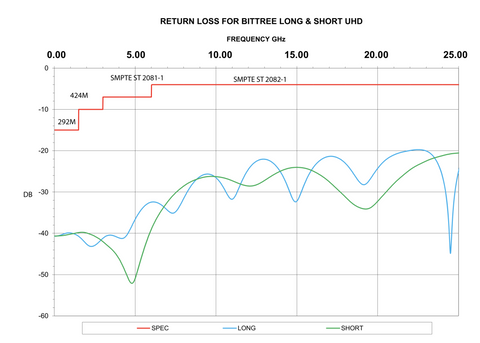Posted in
How to read the Return Loss chart for Bittree Mini WECo Long and Short 12G+ UHD 4K 8K Jacks?
SMPTE ST 2082-1 is the standard developed by SMPTE (Society of Motion Pictures and Television Engineers) for the transmission of single link 12 Gbit/s signal on a coaxial cable, with a nominal impedance of 75 ohms. The SMPTE ST 2082-1 red line on the chart represents the maximum return loss allowed for a component in the transmission path. This return loss is an accurate way of measuring signal reflections. Too great of a reflection can result in a complete loss of signal or bit errors. Ideally, the entirety of the circuit would never exceed the maximum allowable return loss under this SMPTE standard. The result of this return loss test for the Bittree long jack 1MWNBK/S-L and short jack 1MWNBK/S-S offers assurance and proof that Bittree’s 12G+ jacks perform better than the minimum requirement specified by the SMPTE ST 2082-1 standard. This means that there is additional headroom for any other imperfections in the circuit path that would cause return loss. Additionally, Bittree 12G+ jacks perform far beyond the 11.88 GHz clock rate all the way out to 24GHz, allowing 3rd harmonic dissipation. This test is one of the most accurate ways of certifying high-frequency UHD-SDI jack performance.

Why Worry about RL? [1]
HD takes us into a world that is less video and more radio frequency (RF). In fact, an uncompressed high-definition video signal (greater than 1500- MHz bandwidth) is more an RF signal than video signal. Therefore, many aspects of transmission line theory now apply to video signals. The bandwidth of a single uncompressed high-definition video picture now exceeds that of a standard multichannel CATV/broadband signal. Further, the bandwidth limit of HD is often higher than the transmitted channel frequency! With such high frequencies, it is evident that new methods of performance verification are essential.
What Causes RL? [2]
Variations in the impedance of a cable produce RL; therefore, anything that affects impedance tolerance affects RL. This includes the basic construction of a video cable, from the size, shape, and make-up of the center conductor; choice and manufacturing of the insulation or dielectric; and choice of shield elements and materials. The jacket print method can also have an effect on return loss. Return loss can also be dramatically affected by the choice of connectors and other passive components, such as feed-through or bulkhead connectors, patch panels, patch cords, and even the connectors attached to the inputs and outputs of equipment. During installation, return loss can be affected by the treatment of the cable. Bend radius and pull strength are often factors overlooked by wiring crews.
[1] SMPTE Journal, January 2001. Stephen H. Lampen Martin J. Van Der Burgt Carl W. Dole
[2] SMPTE Journal, January 2001. Stephen H. Lampen Martin J. Van Der Burgt Carl W. Dole

Bittree Long Jack 1MWNBK/S-L and Short Jack 1MWNBK/S-S

S64T-1MWNBK // 12G+ MINI-WECO (MIDSIZE) VIDEO PATCHBAY, 2X32, 2 RU
Subscribe to our newsletter and always be the first to hear about what is happening.
© 2024 Bittree

Jack Field
Author